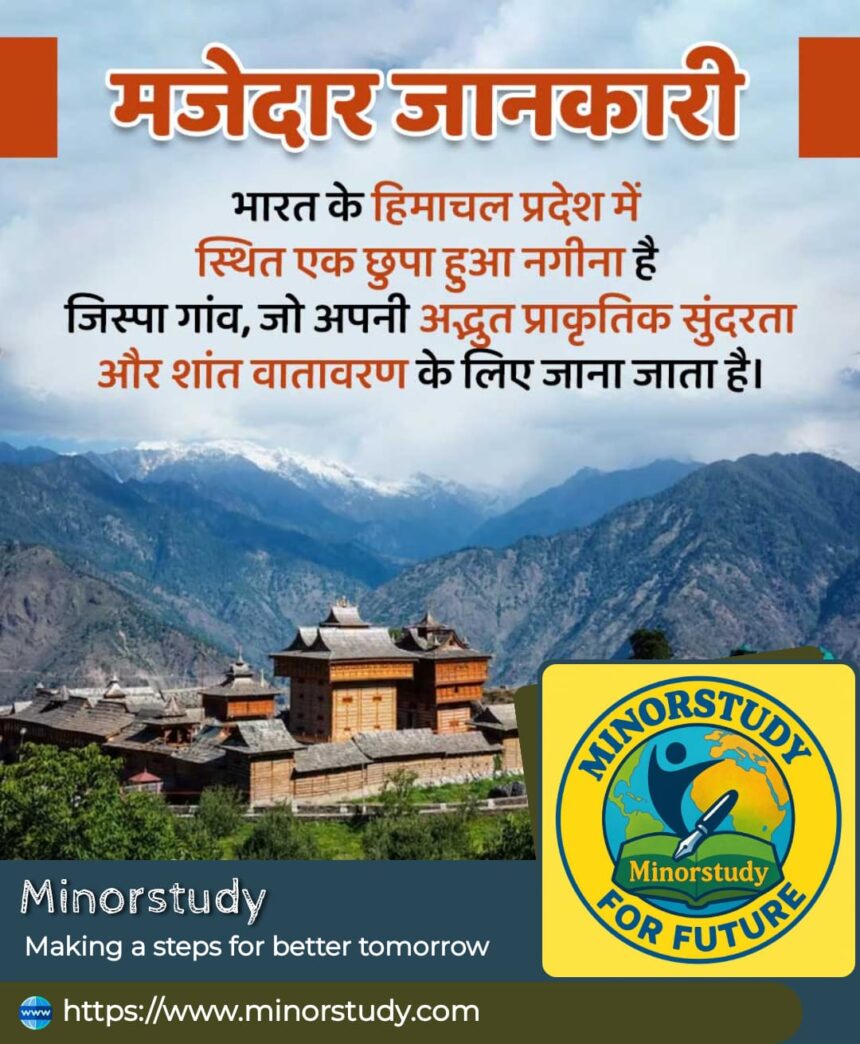🏞️ Fun Facts & Full Guide to Jispa Village – A Hidden Himalayan Gem
Wishing you a moment of calmness and connection with nature.
Jispa Village: If you’ve ever dreamed of escaping the chaos of city life and disappearing into serene Himalayan landscapes, then Jispa village in Himachal Pradesh is your dream come true. Nestled in the Lahaul Valley at an altitude of 3,200 meters (10,500 ft), this tiny, less-explored village is a soulful stop for travelers heading towards Ladakh or Spiti.
- 📜 History of Jispa Village
- 🌟 9 Amazing Fun Facts About Jispa Village
- ⏳ Timeline and Seasonal Flow of Jispa Village
- 🧭 Significance of Jispa Village in Our Lives
- 🕊️ 1. Emotional Detox from Modern Life
- 🌿 2. Gateway to Himalayan Adventures
- 🛕 3. Living Himalayan Culture
- 🌍 4. Ecological Importance
- 🙋♂️ Frequently Asked Questions (FAQs)
- Q1. Where exactly is Jispa located?
- Q2. What is the best time to visit Jispa?
- Q3. Is Jispa safe for family travel?
- Q4. Is acclimatization necessary in Jispa?
- Q5. Can I find accommodation easily?
- 🌺 Wishing You A Serene Visit to Jispa Village
- 📌 Important Points at a Glance
- 🧘♀️ Importance in Life and Society
- 🧾 Conclusion: Daily Life Impact of Knowing Jispa Village
Jispa is not just another village; it’s a place where time slows down, and nature speaks in silence. Let’s explore the history, facts, timeline, significance, FAQs, daily life impact, and much more—written with a human touch and over 1200+ words to make you feel like you’ve already been there.
📜 History of Jispa Village
Jispa Village origins trace back centuries, embedded in the culture of the Lahaul and Spiti tribes. Historically, the area was an important trading halt on the ancient Indo-Tibetan trade route, connecting Himachal Pradesh to Tibet and Ladakh. The inhabitants are mostly Buddhists, and the cultural influence of Tibetan Buddhism is evident in their monasteries, prayers, and festivals.
The village also gained popularity during the development of the Manali-Leh Highway, especially after the construction of Atal Tunnel, which made Lahaul more accessible year-round.
🌟 9 Amazing Fun Facts About Jispa Village
Mini Switzerland Feel: The landscape of Jispa Village with lush green meadows, snow-capped mountains, and the Bhaga River feels like a Himalayan version of Switzerland.
Altitude Adventure: Located at 3,200 meters, it’s a popular acclimatization spot for travelers heading to Leh, helping prevent altitude sickness.
Tiny Yet Rich Museum: The Jispa Rural & Tribal Museum showcases ancient artifacts, tools, costumes, and traditional houses of Lahaul’s tribes.
A Buddhist Haven: Jispa Village is home to stupas, prayer flags, and monasteries, offering peaceful retreats and a chance to understand Tibetan Buddhism.
River of Life: The Bhaga River, a tributary of the Chandrabhaga (Chenab), flows beside the village and provides water, irrigation, and serenity.
Night Sky Magic: Due to its high altitude and zero light pollution, Jispa Village is a paradise for stargazing—you can clearly see the Milky Way!
Local Hospitality: The residents are warm, spiritual, and deeply connected to their land. Homestays offer you authentic food and cultural exchange.
Flora & Fauna: Expect to see yak caravans, Himalayan ibex, wild roses, and rare birds—a delight for nature lovers and photographers.
Silent Winter Wonder: In winters, the village is blanketed in snow and looks like a frozen fairy tale, though most people migrate to lower altitudes during this time.
⏳ Timeline and Seasonal Flow of Jispa Village
| Month | Description |
|---|---|
| May – June | Snow begins to melt. Spring meadows bloom. Pleasant travel conditions begin. |
| July – Sept | Peak tourist season. Rivers flow strong, climate is cool and fresh. |
| Oct | Last phase of accessibility before heavy snowfall starts. |
| Nov – Mar | Village remains largely cut off due to snow; minimal activity. |
| April | Slow reopening of roads; nature reawakens. |
🧭 Significance of Jispa Village in Our Lives
🕊️ 1. Emotional Detox from Modern Life
Jispa offers a digital detox. There’s limited network coverage. The silence of the valley helps one reconnect with their inner self.
🌿 2. Gateway to Himalayan Adventures
Jispa is a starting point for treks and bike rides into Zanskar and Leh. It prepares your body and soul for the raw terrain ahead.
🛕 3. Living Himalayan Culture
Jispa preserves and showcases Himachali tribal life without commercialization, allowing people to understand simple, sustainable living.
🌍 4. Ecological Importance
The Bhaga River and the surrounding flora make it an important ecological hotspot, providing water and oxygen-rich zones in an otherwise barren region.
🙋♂️ Frequently Asked Questions (FAQs)
Q1. Where exactly is Jispa located?
Jispa is in Lahaul Valley, around 20 km from Keylong and 138 km from Manali, on the Leh-Manali Highway.
Q2. What is the best time to visit Jispa?
Between May to October. Monsoons (July-August) are lush but can bring road challenges.
Q3. Is Jispa safe for family travel?
Absolutely. It is a calm, family-friendly destination with homestays, peaceful trails, and local food.
Q4. Is acclimatization necessary in Jispa?
Yes, especially if you’re going higher to Leh or Sarchu. Spending a night in Jispa helps your body adjust.
Q5. Can I find accommodation easily?
Yes, there are budget guesthouses, camps, and luxury cottages available. Some also offer bonfire and cultural nights.
🌺 Wishing You A Serene Visit to Jispa Village
“Wishing you a peaceful journey to Jispa—may the winds carry away your worries and the mountains fill you with strength.”
Other wishes you can use:
“Let your heart find stillness in the serenity of Jispa.”
“May the Himalayas guide your spirit just like Jispa guides the travelers.”
“Wishing you endless sunsets, quiet rivers, and Himalayan magic at Jispa.”
📌 Important Points at a Glance
📍 Location: Himachal Pradesh, Lahaul Valley
🌄 Altitude: 3,200 m
🛣️ Access via: Manali-Leh Highway
🌿 Major attraction: Nature, Culture, Stargazing, River
🕍 Must-visit: Rural Museum, Bhaga River, Local Gompas
🏡 Best stay: Homestays & riverside camps
🧘 Ideal for: Writers, travelers, nature lovers, spiritual seekers
🧘♀️ Importance in Life and Society
Personal Level:
Encourages mindfulness, away from the noise.
Reignites love for slow living and natural surroundings.
Teaches gratitude for simplicity, warmth, and clean air.
Societal Level:
Promotes eco-tourism and local empowerment.
Preserves tribal culture and heritage of the Himalayan region.
Acts as a cultural bridge between tradition and modern exploration.
🧾 Conclusion: Daily Life Impact of Knowing Jispa Village
Jispa Village: Knowing about Jispa is more than just travel trivia. It gives us a real-world example of how communities live sustainably, in harmony with nature. It reminds us to slow down, breathe, observe, and connect.
Every once in a while, we all need a Jispa in our lives—a quiet place to realign, rejuvenate, and rekindle joy.
So pack light, carry respect, and leave only footprints.
Jispa is not just a village—it’s a feeling, a moment in time, and a lesson in life.









Всё о металлообработке https://j-metall.ru и металлах: технологии резки, сварки, литья, фрезеровки. Свойства металлов, советы для производства и хобби.
Сливы курсов по подготовке к ЕГЭ https://courses-ege.ru
paris sportif foot telecharger 1xbet
football africain parier foot en ligne
webmagnet.click – Overall, professional vibe here; trustworthy, polished, and pleasantly minimal throughout.
advista.click – Mobile version looks perfect; no glitches, fast scrolling, crisp text.
growthflow.click – Navigation felt smooth, found everything quickly without any confusing steps.